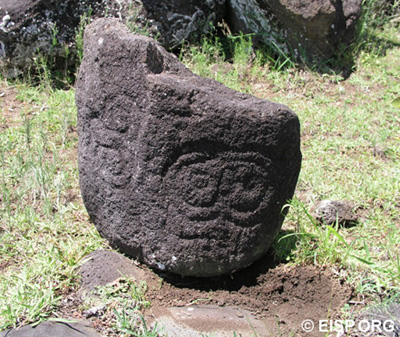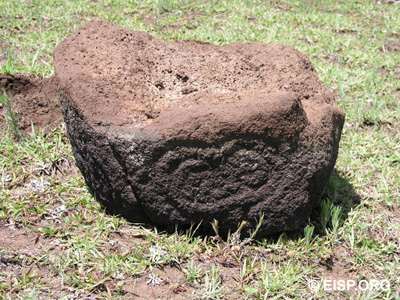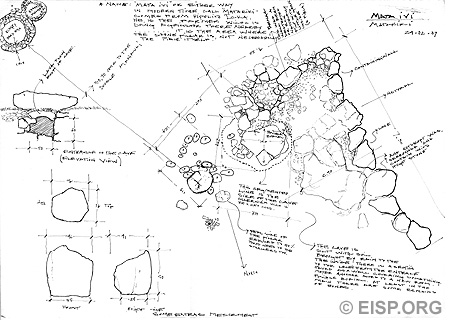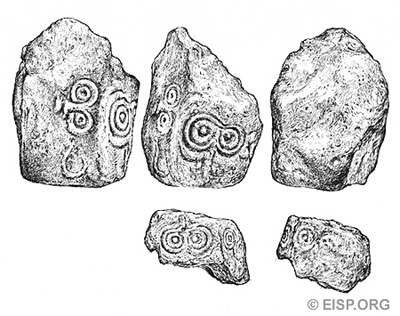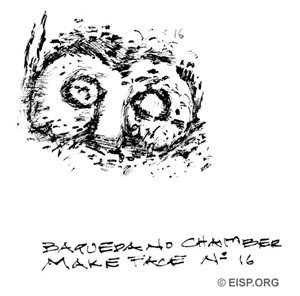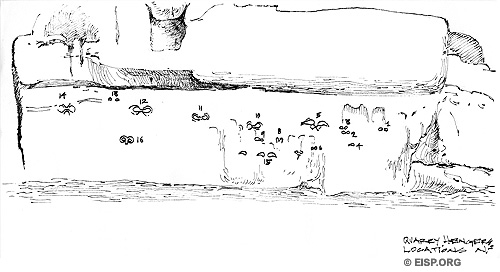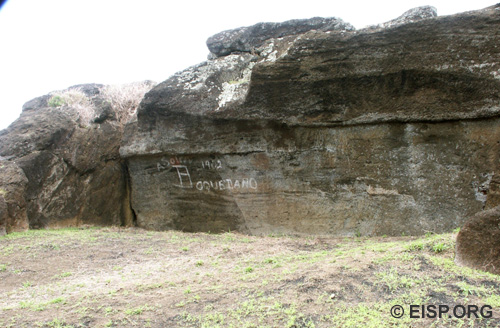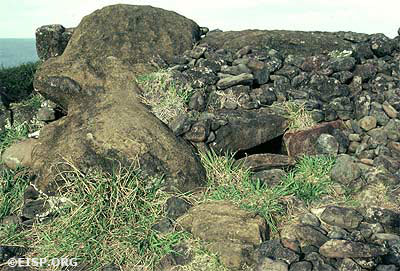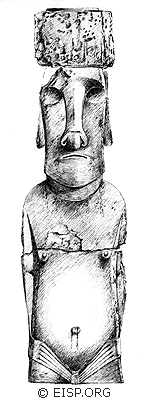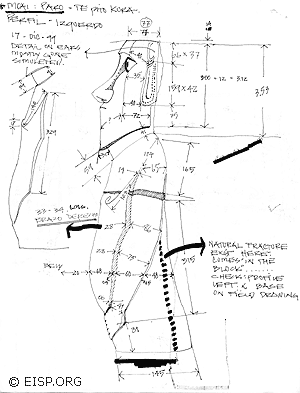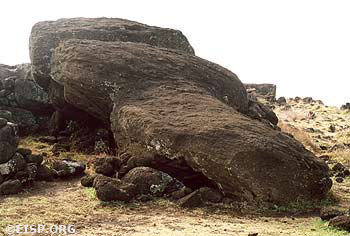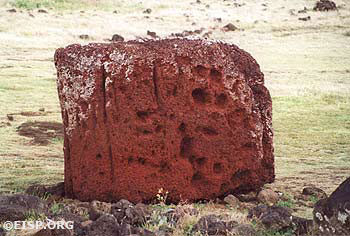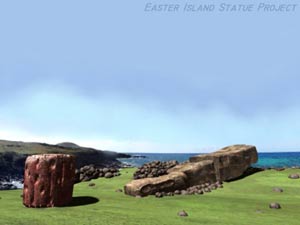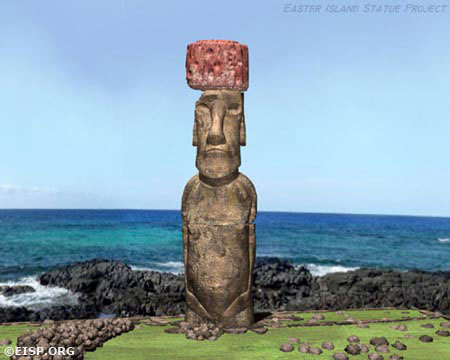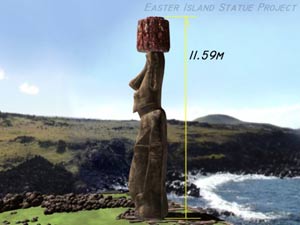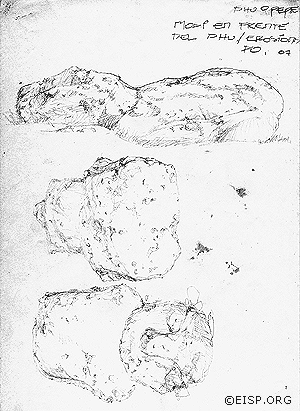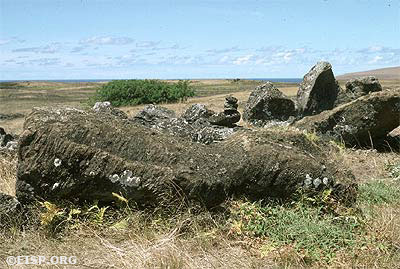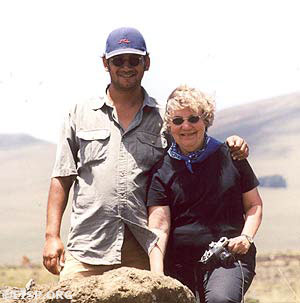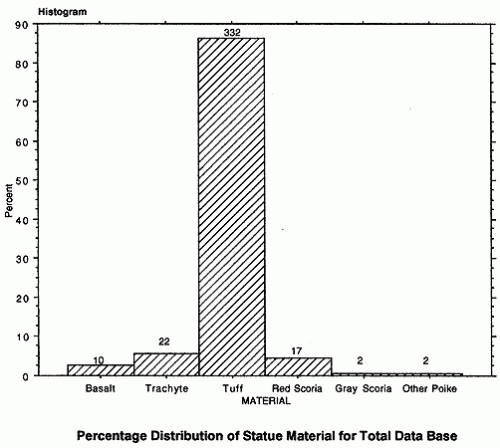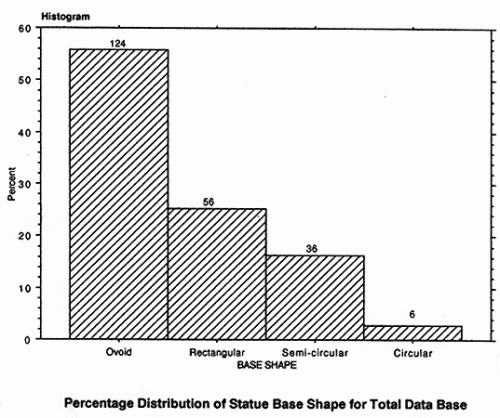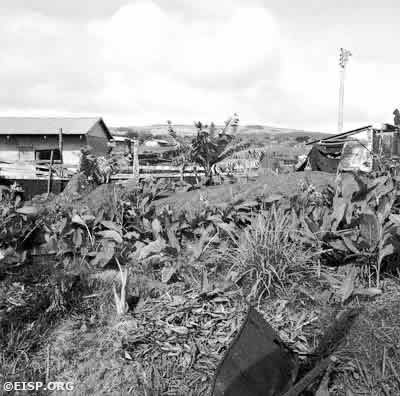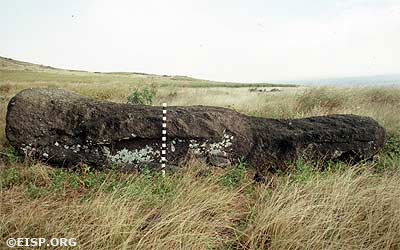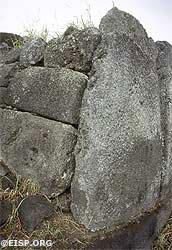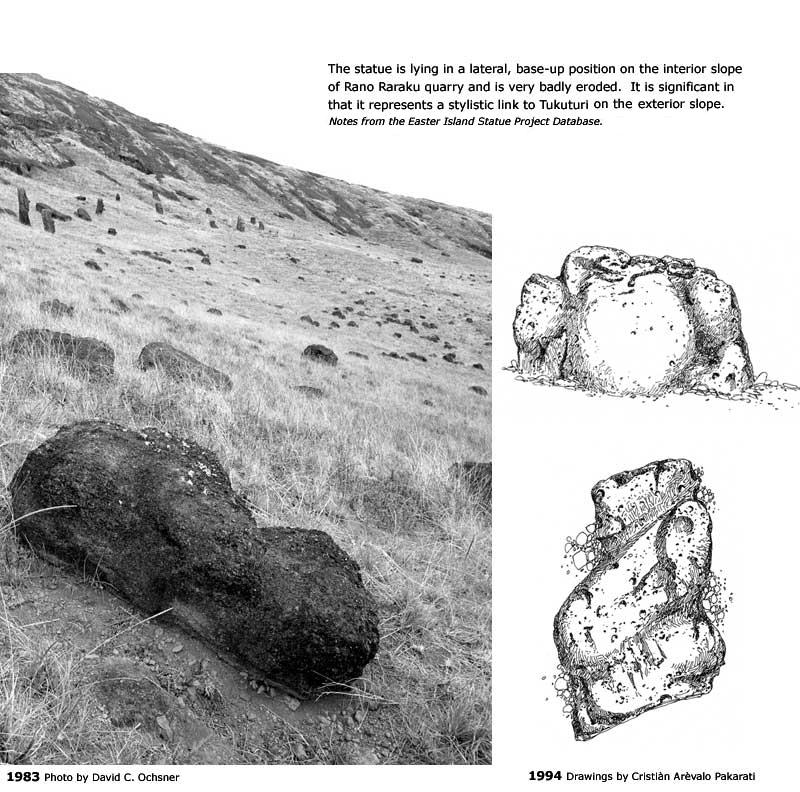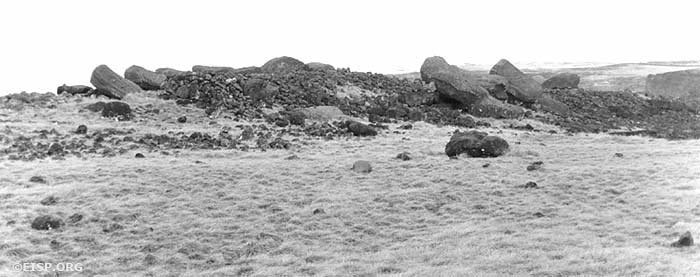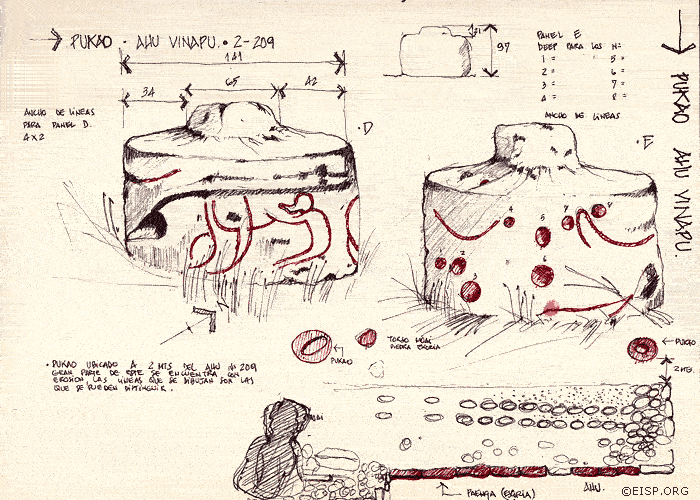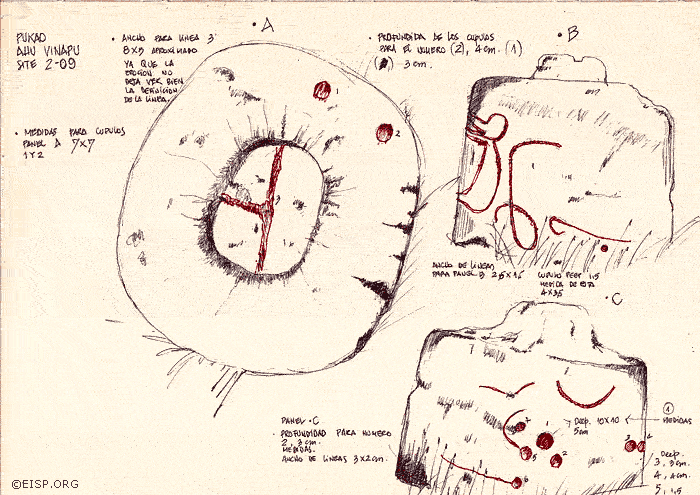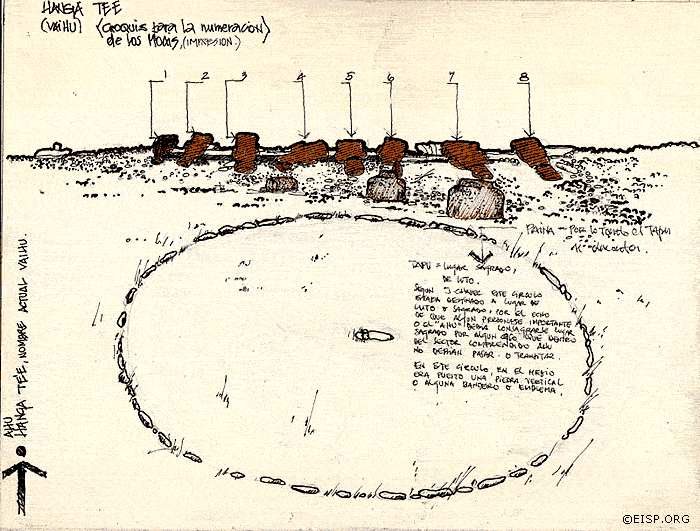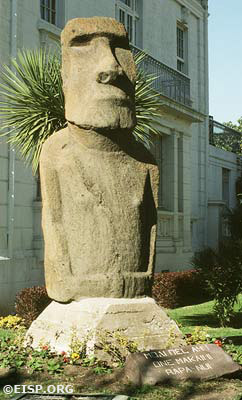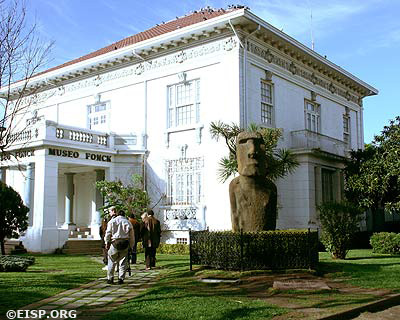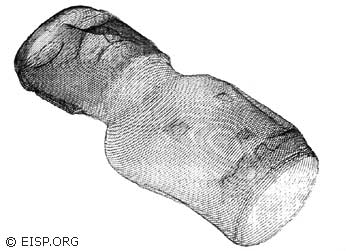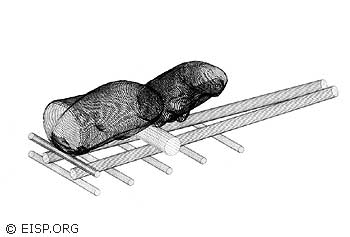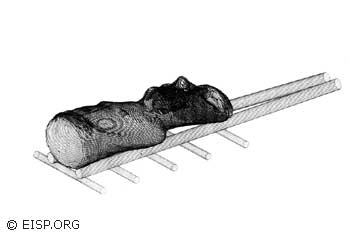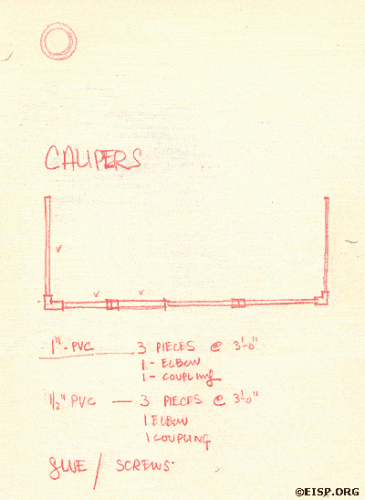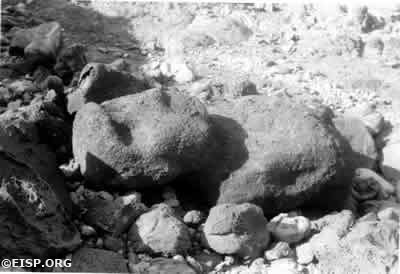Some interesting field notes and documents from the EISP Archives. Click on images for a larger view.
Makemake Rock Art Motifs
Ahu Vinapu: Moai 02-210-004
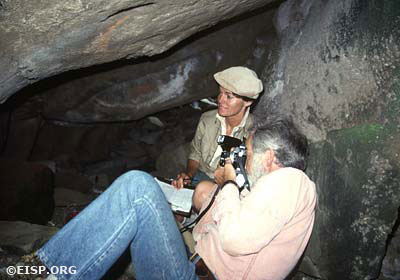
Jo Anne Van Tilburg and EISP photographer David C. Ochsner on site at Vinapu. © EISP/JVT/Photo: M.A. Clark.
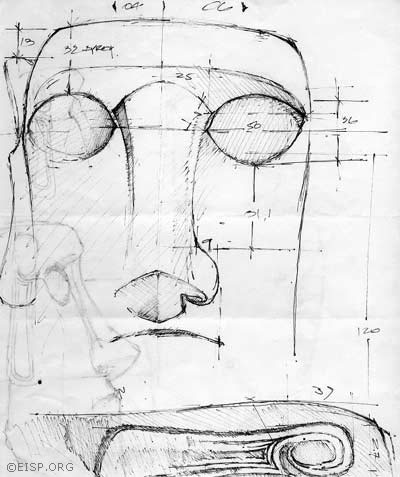
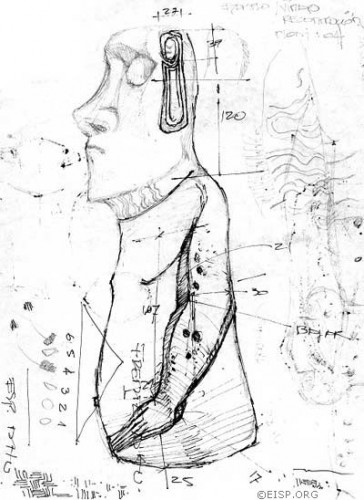
 (left) This statue illustrates the ceremonial use of a fallen moai into historic time. The site was excavated by W. Mulloy and reported in the published papers of the Norwegian Archaeological Expedition. Although there were some anomalies in the descriptions of the statues, Mulloy’s team also produced a conjectural reconstruction view of the statues standing upright on the platform.
(left) This statue illustrates the ceremonial use of a fallen moai into historic time. The site was excavated by W. Mulloy and reported in the published papers of the Norwegian Archaeological Expedition. Although there were some anomalies in the descriptions of the statues, Mulloy’s team also produced a conjectural reconstruction view of the statues standing upright on the platform.
RELATED RECORD: See Raúl Paoa’s sketches, which were used as the basis of the pukao in this reconstruction.
Statues Along Transport Roads
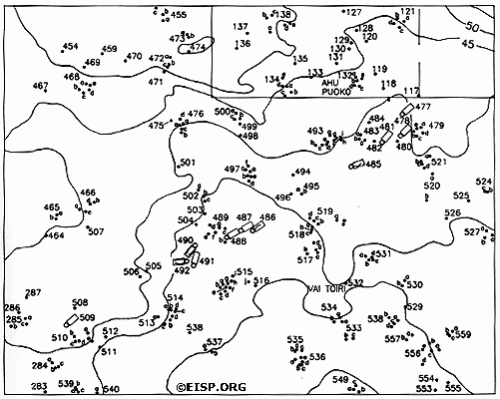
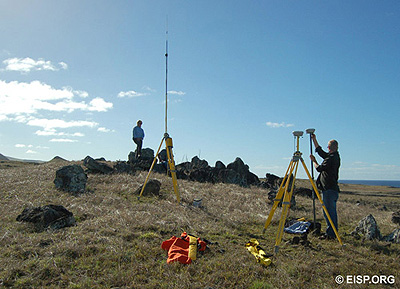
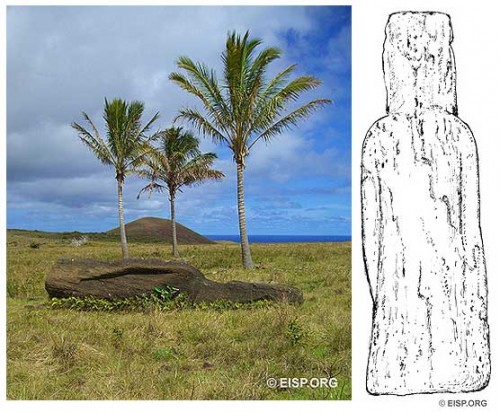
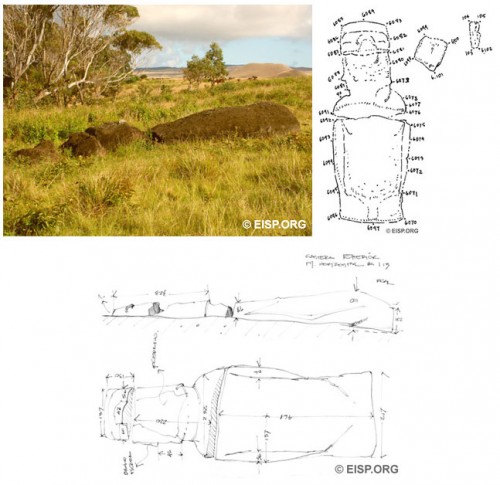
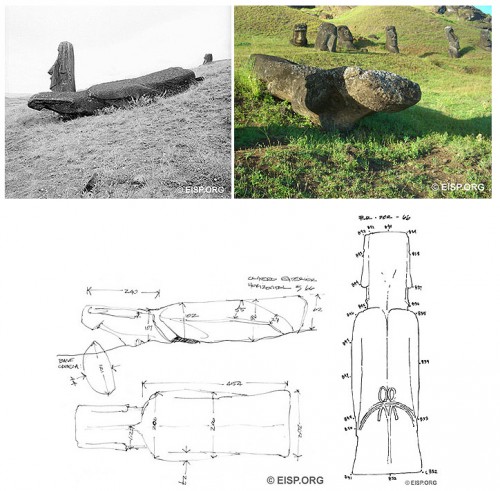
In 2006-2007, EISP resurveyed the statues along the “transport roads” and updated the visual documentation record for each statue. This new data was used to create a more accurate map that shows unique statue details.
Statue Shape Variation
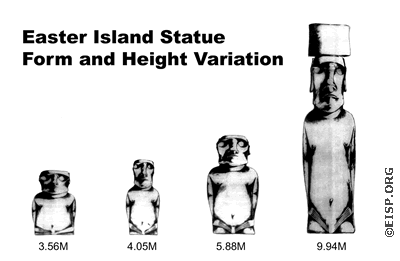 Statue type category examples.
Statue type category examples.
©EISP/JVT/Drawing: Cristián Arévalo Pakarati.
Moai Paro Digital Reconstruction
Moai Paro (30-220-001) is the tallest (989 cm) statue ever successfully raised upright on a ceremonial platform. It weighs approximately 82 m tons and wore a red scoria pukao (30-220-004) that added another 11-12 m tons of weight to the statue. Previously investigated by C. Smith and W. Mulloy, we documented it first in 1984 and 1991.
In an effort to better understand Moai Paro in the context of Ahu Te Pito Kura and its natural environs, in 1999 and 2000-2002 we digitally reconstructed the statue using photographs, measurements and detailed drawings. On-site documentation required for this work was carried out by Cristián Arévalo Pakarati.
Ahu O’Pepe 20-001
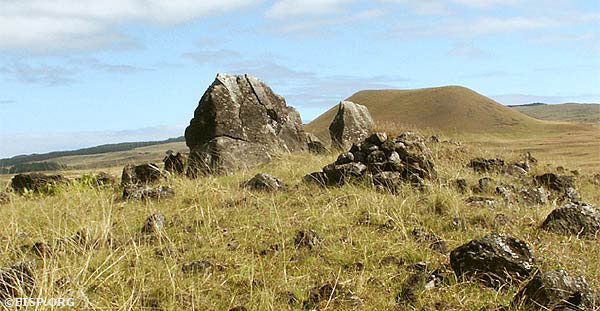
Ahu O'Pepe (20-001), an inland ahu, once held seven moai and as such may be compared to Ahu Akivi (16-001).. © 2003 EISP/JVT/Photo: A. Perlin.
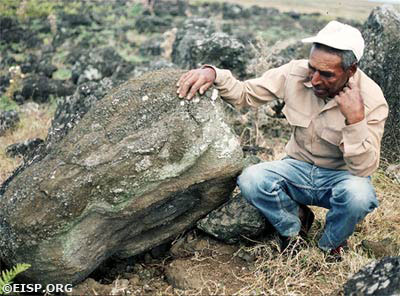
Felipe Teao A. with a torso, recarved into bas-relief komari (vulva). ©1987 EISP/JVT/Photo: D. C. Ochsner.
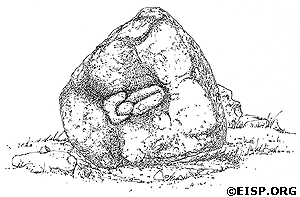
Drawing of moai Torso 20-001-006 recarved as a bas-relief komari (vulva), Ahu O'Pepe©1991 EISP/JVT/Drawing: C. Arévalo P.
RELATED RECORD: Two moai removed from Ahu O’Pepe are currently at the National Museum of Natural History, Smithsonian Institution.
Statue Material & Base Shape Distribution Histograms
Statue Distribution Map
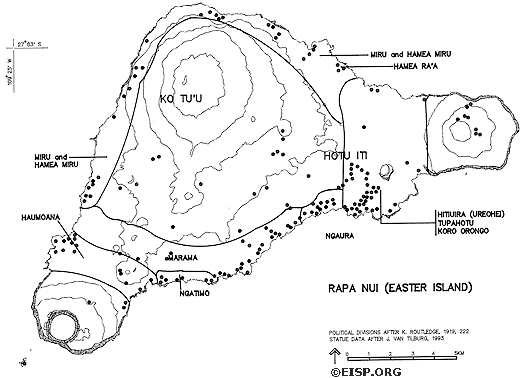 Distribution of monolithic statue sites relative to Routledge’s (1919) kin group divisions. Computer drafting by Gordon Hull. From Easter Island Archaeology, Ecology and Culture by Jo Anne Van Tilburg. London: British Museum Press and Smithsonian Institution Press, 1994.
Distribution of monolithic statue sites relative to Routledge’s (1919) kin group divisions. Computer drafting by Gordon Hull. From Easter Island Archaeology, Ecology and Culture by Jo Anne Van Tilburg. London: British Museum Press and Smithsonian Institution Press, 1994.
Ahu Tangi Uka
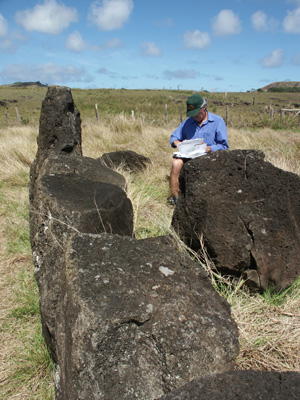
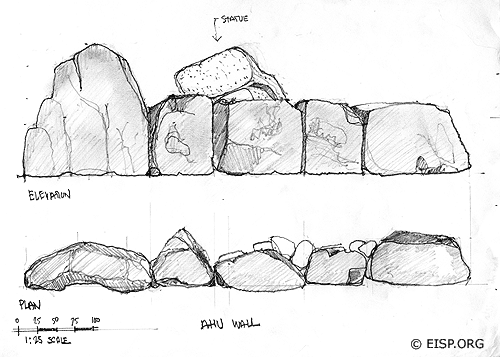
This is a small ahu located within the defined boundary of “inland” sites (more than 150 m inland). It is on private land and not accessible to the public. One large moai is present on the site. The platform itself is perfunctory, with only a single course of upright stones forming the rear wall.
Rano Raraku Interior, Moai RR-03C-011
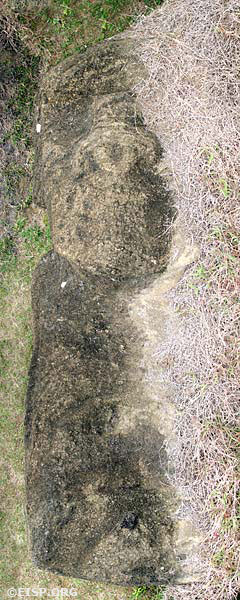
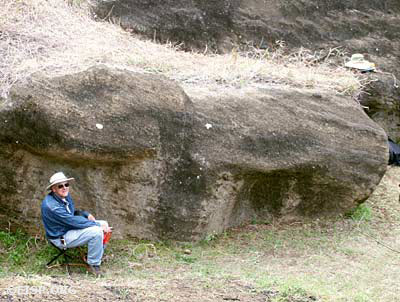
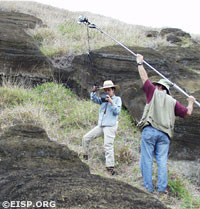
(Left) A composite overhead image of moai C-7 in the Rano Raraku interior quarry. Separate digital photographs were taken from a camera mounted on a hand-held boom hoisted over the moai. An attached video monitor acted as a remote viewfinder. These photos were then composited together in Photoshop to make the overhead view. The context of this moai can be seen in this map. Digital compositing by Debra Isaac.
Smithsonian Moai SI-WDC-001
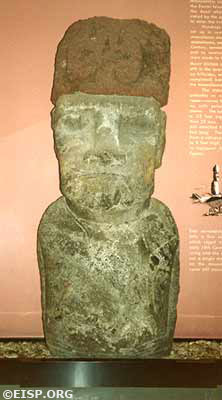
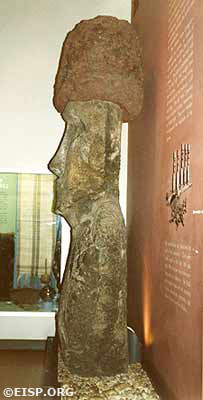
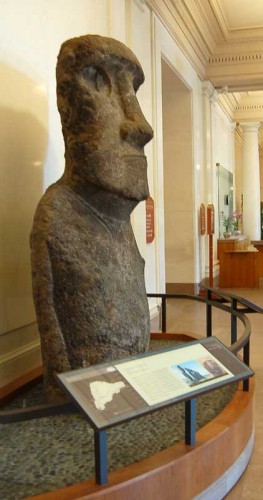 (far left, 2 images) EISP archive photos of Moai SI-WDC-001, located at the Smithsonian Institution in Washington DC, USA. Photos by Jo Anne Van Tilburg, 1986 © JVT/EISP.
(far left, 2 images) EISP archive photos of Moai SI-WDC-001, located at the Smithsonian Institution in Washington DC, USA. Photos by Jo Anne Van Tilburg, 1986 © JVT/EISP.
(left) Moai SI-WDC-001 is currently installed inside the Constitution Ave. entrance of the National Museum of Natural History, Smithsonian Institution in Washington D.C.
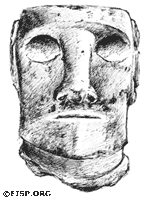
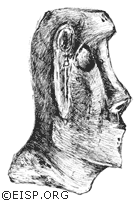
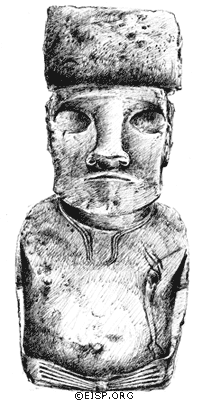
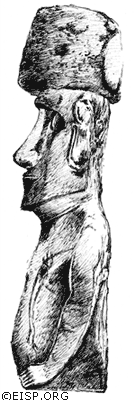
EISP archive drawings of Head SI-WDC-002 and Moai SI-WDC-001, both originally from Ahu O’Pepe, are currently in the collection of the Smithsonian Institution. Drawings by Cristián Arévalo Pakarati, 2000© JVT/EISP.
RELATED RECORD: Cristiàn Arèvalo Pakarati, Rapanui artist and EISP co-investigator with Dr. Adrienne L. Kaeppler, curator of oceanic ethnology at the National Museum of Natural History, Smithsonian Institution, on site at Ahu O’Pepe.
Trachite Statue, Poike
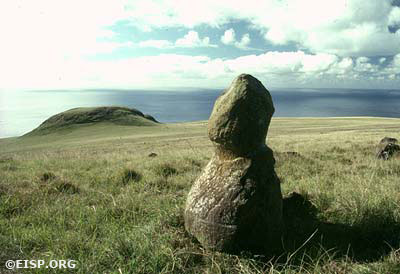
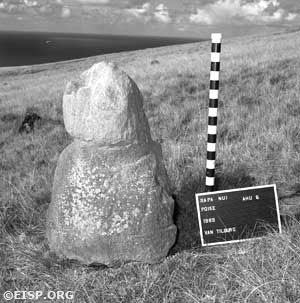
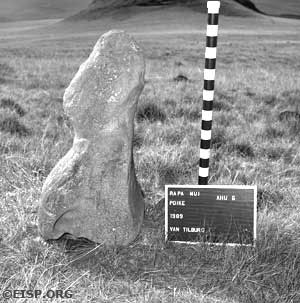
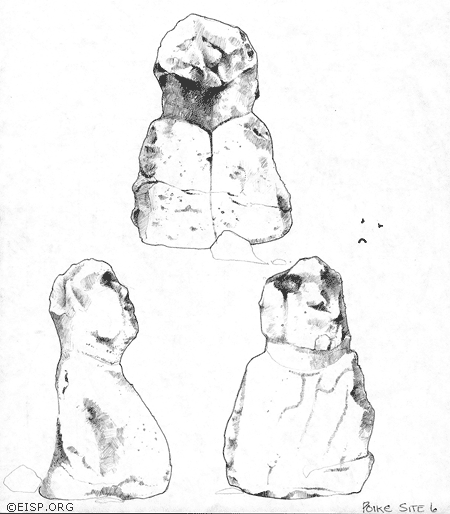
Trachite statue, Poike, Rapa Nui (Easter Island), 1989. Photos by David C. Ochsner, drawings by Cristián Arévalo Pakarati © JVT/EISP.
Palau Statue Survey Map & Data Table: 1987
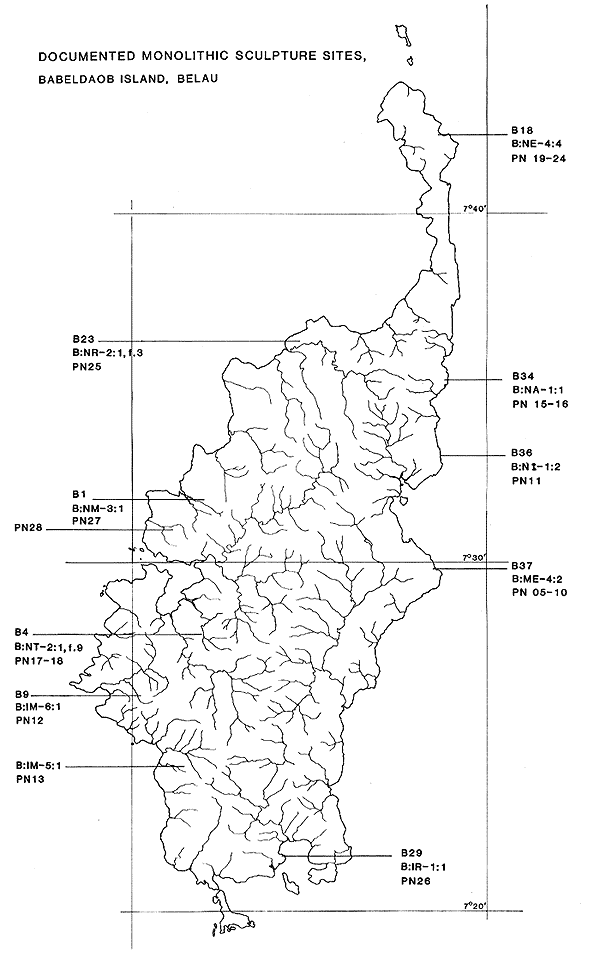
Location of monolithic sculpture sites recorded during our 1987 fieldwork on Babeldaob island, Republic of Belau, Micronesia.
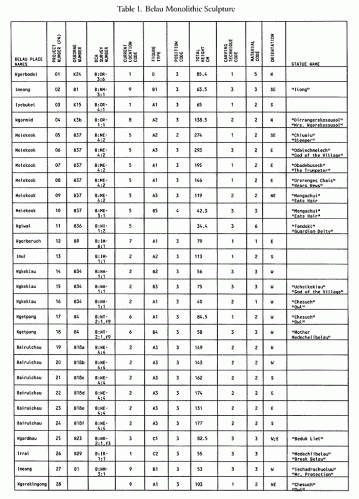
Table listing twenty-eight stone monoliths recorded during our 1987 fieldwork in Belau, Micronesia. Project number 27 was said to resemble Easter Island sculpture.
Trachite Statue, Ahu 1, Poike
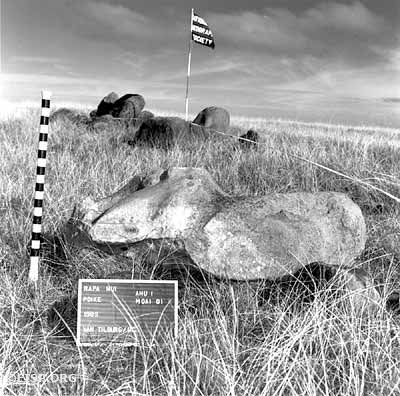
EISP archive photo of trachite statue (on Ahu 1), Poike, Rapa Nui (Easter Island), 1989. Photo by David C. Ochsner, © JVT/EISP.
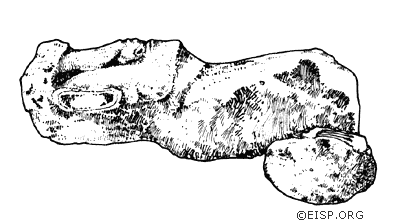
EISP archive drawing of trachite statue (on Ahu 1), Poike, Rapa Nui (Easter Island), 1989. Drawing by Cristián Arévalo Pakarati, © JVT/EISP.
Basalt Statue, PSE 84
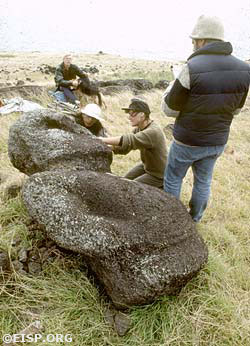
EISP crew Noemi Pakarati, Jo Anne Van Tilburg, Curtiss H. Johnson (J. Weber in the background) documenting the basalt Moai 84, Rapa Nui (Easter Island), 1989. Photo by David C. Ochsner, copyright JVT/EISP.
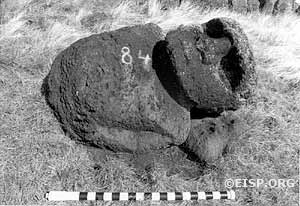
EISP archive photo of basalt Moai 84, Rapa Nui (Easter Island), 1989. Photo by David C. Ochsner, copyright JVT/EISP.
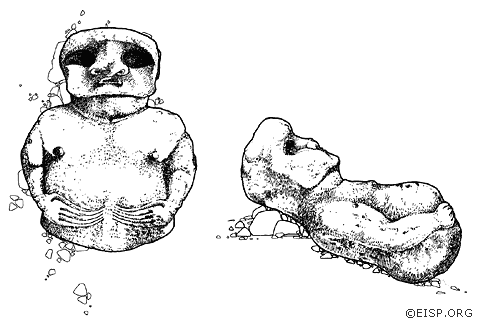
EISP archive drawing by Cristián Arévalo Pakarati of basalt Moai 84, Rapa Nui (Easter Island), 1989.
Easter Island Quadrangle Map
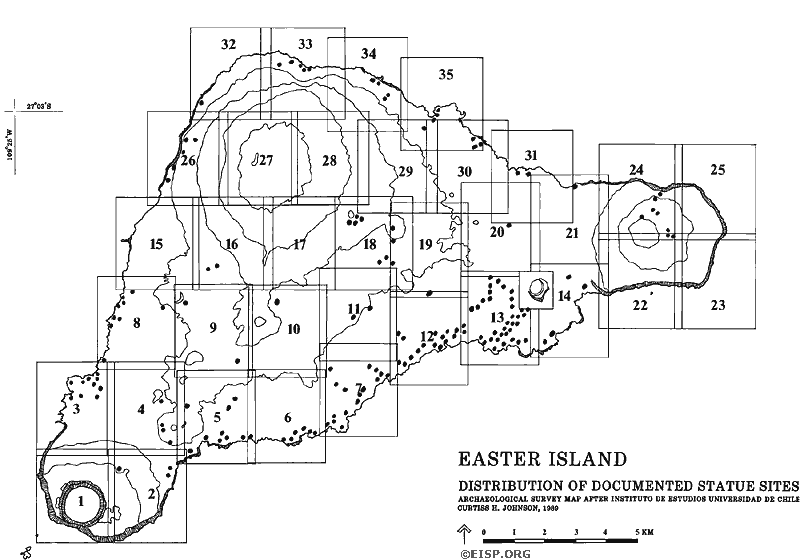 Map showing the distribution of documented statues and statue sites to 1989. Archaeological survey quadrangles after the University of Chile. EISP data. Drafting by Curtiss H. Johnson, 1989.
Map showing the distribution of documented statues and statue sites to 1989. Archaeological survey quadrangles after the University of Chile. EISP data. Drafting by Curtiss H. Johnson, 1989.
Moai A Hani
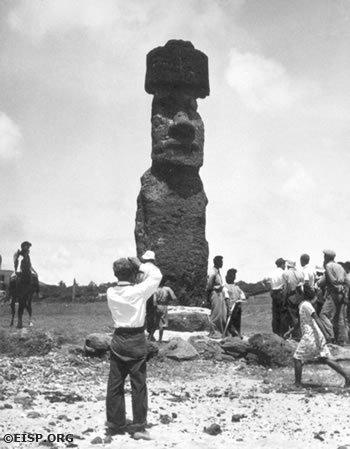
Dr. Raymond Dillon or John Hayes from the yacht Yankee, taking a photo of Moai A Hani in 1938-40. © EISP/JVT/Courtesy of Jennifer Johnson.
Ahu Tongariki: Moai 14-548-009
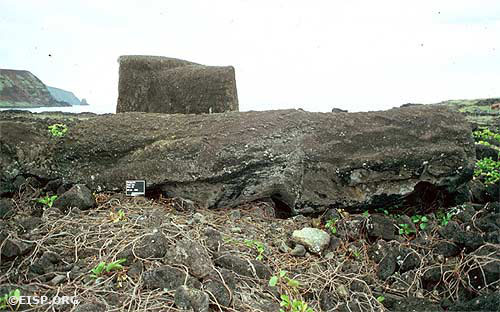
Prone Moai 14-548-009 on the unrestored site of Ahu Tongariki. The ahu was destroyed by a tsunami in 1960. © 1984 EISP/JVT/Photo: D.C. Ochsner.

Drawing of prone Moai RR-548-009 showing incised 'tattoo' lines on the neck. © 1992 EISP/JVT/Drawing: C. Arèvalo Pakarati.
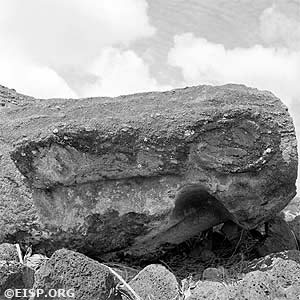
Detail of the broken right ear on Moai 14-548-009 at Ahu Tongariki © 1984 EISP/JVT/Photos: D. C. Ochsner.
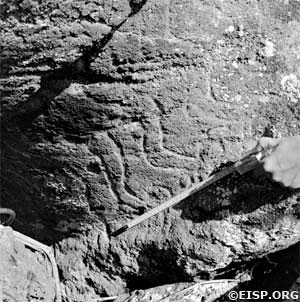
Incised lines on the neck of prone Moai 14-548-009 at Ahu Tongariki © 1984 EISP/JVT/Photos: D. C. Ochsner.
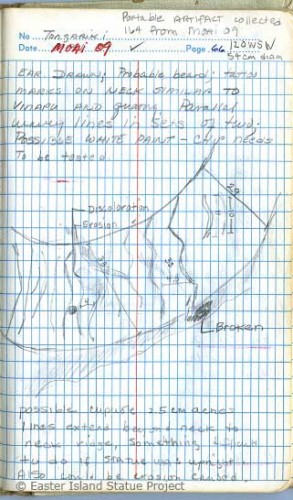
Pages from Jo Anne Van Tilburg's field book detailing attributes of the right ear (left) and incised 'tattoo' on prone Moai 14-548-009. © 1984 EISP/Notes: J. Van Tilburg.
Ahu Vai Mata 32-059 & Moai 32-023-001
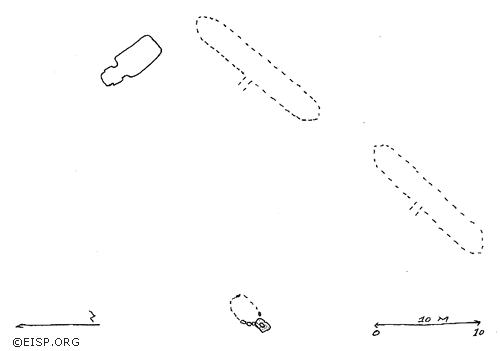
Sketch map showing Moai 32-023-001 and associated features related to Ahu Vai Mata. © 1983 EISP/JVT/Sketch: Frank Bock.
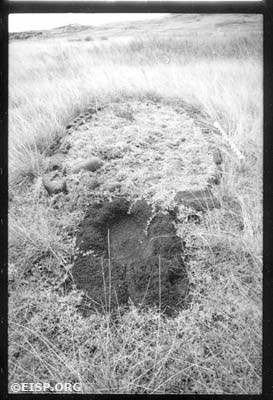
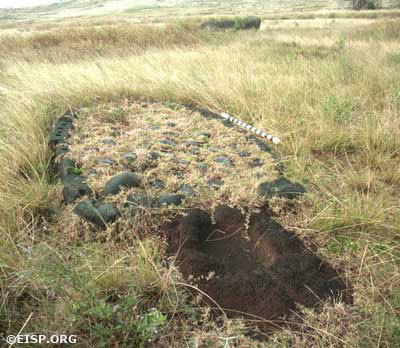 Our field crew found a very unusual oval, paved feature 32-023-004 with a partially buried oval red scoria basin incorporated. Subsequent excavation by the University of Chile revealed an extended burial dated to the 1600s. Rapa Nui (Easter Island) Photos taken in 1984 and 1989 by David C. Ochsner, © EISP/JVT.
Our field crew found a very unusual oval, paved feature 32-023-004 with a partially buried oval red scoria basin incorporated. Subsequent excavation by the University of Chile revealed an extended burial dated to the 1600s. Rapa Nui (Easter Island) Photos taken in 1984 and 1989 by David C. Ochsner, © EISP/JVT.
Rano Raraku Slope, Small Moai “Little Tukuturi”
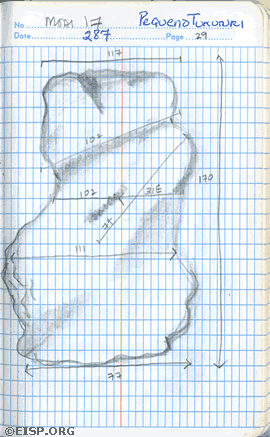
A page from Dr. Van Tilburg's field book shows the moai labeled as "Pequeno Tukuturi", with measurements.
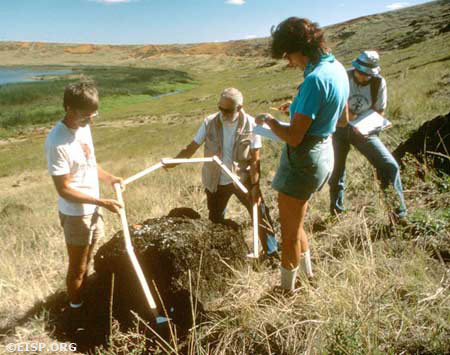
Dr. Steve Williams, Jo Anne Van Tilburg, Dr. Frank Bock and A.J. Bock measuring Little Tukuturi with large-scale calipers.© EISP/JVT/Photo: D. C. Ochsner.
Ahu Akahanga 07-584
Ahu Akahanga (07-584), surveyed by EISP in 1983. Plans drawn by Johannes Van Tilburg, with conjectural reconstruction of three statues (drawn by Cristián Arévalo Pakarati) and associated with platforms 1, 3, and 4.
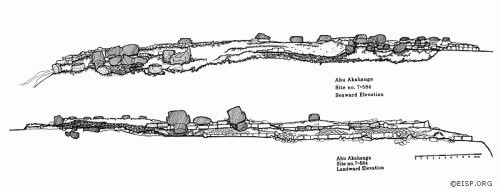
Plan view of Ahu Akahanga (07-584) seaward side (top) and landward side, by Johannes Van Tilburg, 1983.
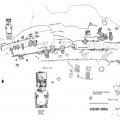
Plan view of Ahu Akahanga (7-548) with conjectural restoration of three moai, each with a different ahu construction. Plan drawn by Johannes Van Tilburg, 1983. Reconstructed statues drawn by Cristian Arevalo Pakarati.
Ahu Akahanga 07-581
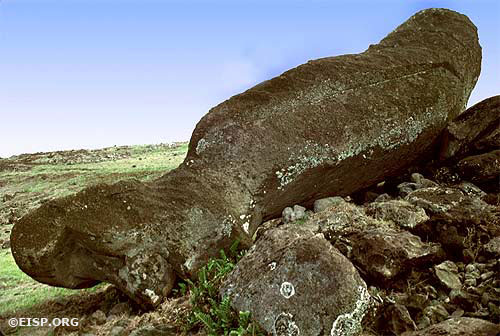
Moai 07-581-001, which fell in the process of being moved to or raised on the ahu. © 1989 EISP/JVT/Photo: D. C. Ochsner.
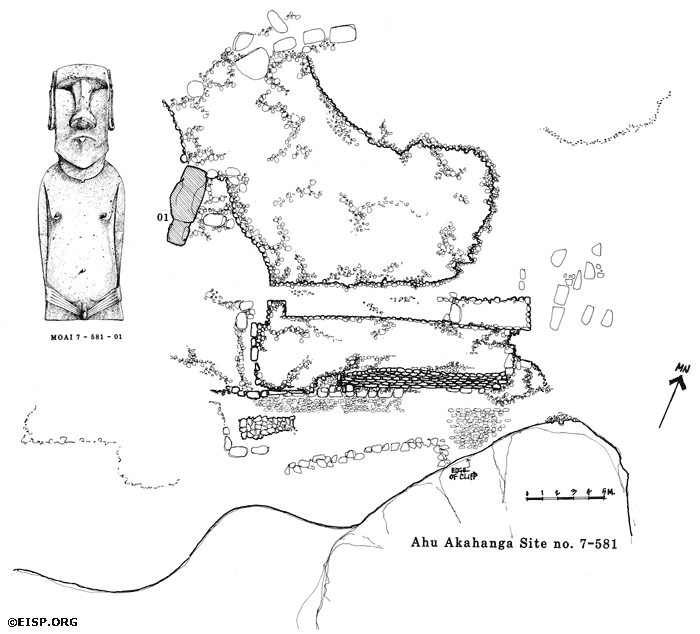
Ahu Akahanga, site 07-581. © EISP/JVT/Plan: Raul Paoa Ika, 1983, Drawing: Cristiàn Arèvalo Pakarati, 1989.
Vinapu Pukao, 02-210
EISP field sketches by Raúl Paoa of pukao (topknots) found at Vinapu, 1983. These were used in the process of visually reconstructing Moai 02-210-004.
Ahu Vaihu 06-255

EISP plan showing the projected line indicating the curvature of the seaward wall, Ahu Vaihu (6-255), by Raúl Paoa, 1983.EISP field sketches of Ahu Vaihu (06-255) by Raúl Paoa, 1983.
Moai at the Fonck Museum, Viña Del Mar, Chile
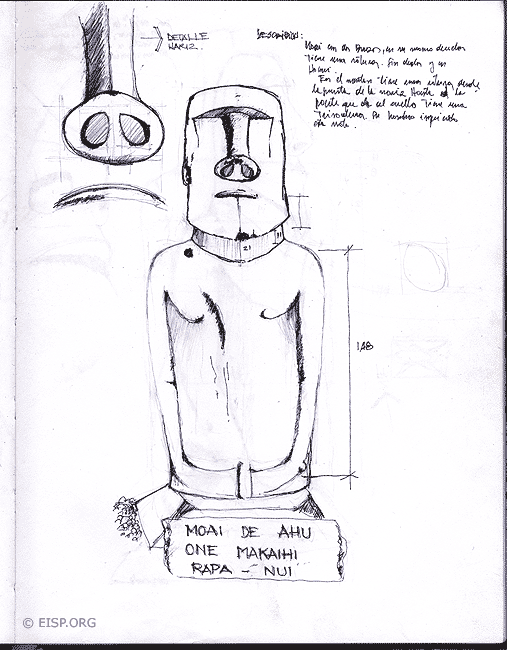
A page from Raúl Paoa’s sketch book, detailing the moai standing outside the Fonck Museum in Viña Del Mar, Chile. ©EISP/JVT/Sketch: Raúl Paoa.
Transport Experiment: Measurement Diagrams & Models
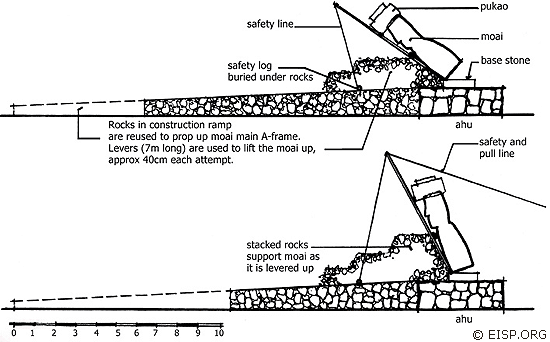
Drawings by Jan Van Tilburg depict our method of raising the statue. Supervised by Raphael Rapu, this part of the work was jointly directed by Van Tilburg and C. Cristino. ©1998 EISP/JVT.
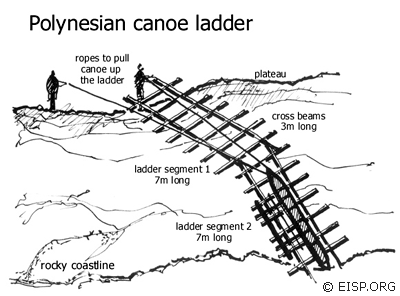
Drawings by Jan Van Tilburg showing the Polynesian canoe ladder, the basic design concept of our statue transport A-frame sledge.
Wire diagrams arrived at after photogrammetric work accomplished at Ahu Akivi depict the statistically average statue used in computer simulations and then in our transport experiment. ©1992 EISP/JVT.
Measuring Calipers
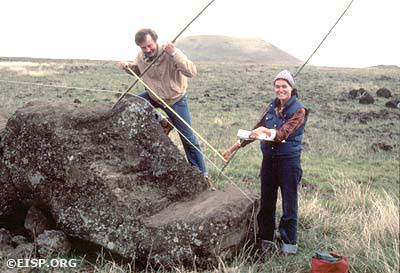
Andy Anderson and Jo Anne Van Tilburg improvising with bamboo poles as measuring devices, Easter Island (Rapa Nui). DCO/JVT.
Bas-relief Dorsal Designs
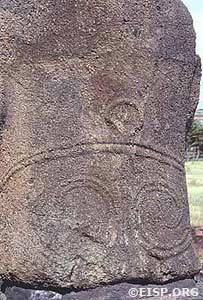
Bas-relief dorsal design on the back of an upright statue, Ahu Nau Nau, Anakena, Easter Island (Rapa Nui). DCO/JVT
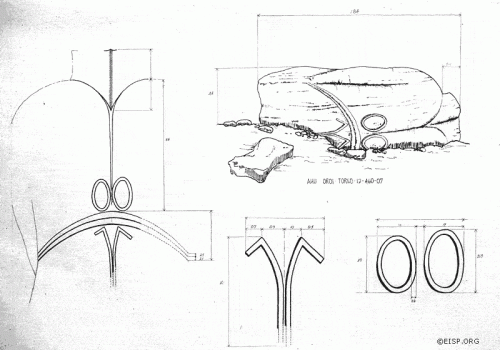
Detail of a similar but more complex design on the back of a fallen and broken torso, Ahu Oroi, Rapa Nui (Easter Island), 1983. Drawn by Raúl Paoa, EISP.
Sketch of Rano Raraku Exterior Quarry
Rano Raraku Exterior Quarry: Moai sketches and neck tracings (RR-002-077)
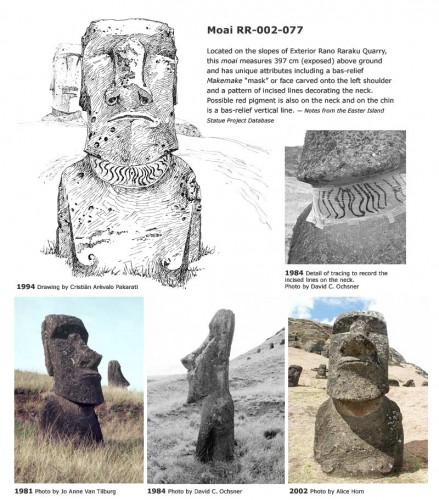
Moai RR-002-077 Located on the slopes of Exterior Rano Raraku Quarry, this moai measures 397 cm (exposed) above ground and has unique attributes including a bas-relief makemake ‘mask’ or face carved onto the left shoulder and a pattern of incised lines decorating the neck. Possible red pigment is also on the neck and on the chin is a bas-relief vertical line. — Notes from the Easter Island Statue Project Database
Ahu Akahanga, Moai 07-585-001
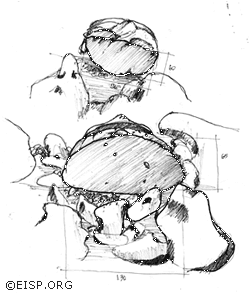
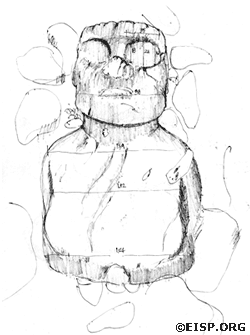
Field sketches of Moai 07-585-001, top of head (upper), base, and front view.
©EISP/JVT/Sketch: Raúl Paoa Ika.
 English
English  Español
Español 